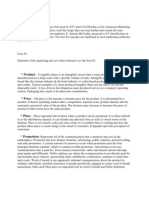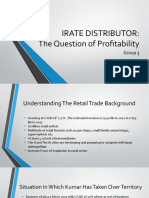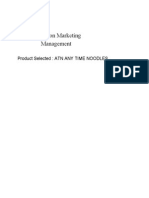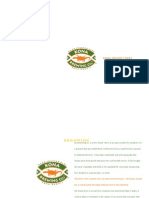Parle G
Parle G
Uploaded by
sushrut7Copyright:
Available Formats
Parle G
Parle G
Uploaded by
sushrut7Original Description:
Copyright
Available Formats
Share this document
Did you find this document useful?
Is this content inappropriate?
Copyright:
Available Formats
Parle G
Parle G
Uploaded by
sushrut7Copyright:
Available Formats
Case Parle G
Parle G is low cost Biscuit brand in India. India was third largest biscuit producer in the world. Most of the growth in industry is fuelled by domestic demand. Pressure from increasing raw material costs and falling margins presents Parle with a difficult pricing decision. However, it is difficult for company to increase prices as its demand is highly elastic. Further, biscuit manufacturing can be divided in two sectors organised and unorganised. Organised sector comprises around 60% of Indian Market. In the organised sector five main categories of biscuits are glucose, marie, sweet, cream and milk. Out of these Glucose is high volume low margin product. Sweet, cream and milk cookies are usually sold at higher margins. All producers usually try to operate at all these categories. As a result there is intense competition in all the segments. The company segmented its customers for Parle-G into two types: retail consumers and institutional consumers. Major section of it is children and mothers, comprising the first sector and contributing 60% of target market. The teenaged consumers were targeted for better influence among non-consuming customers of the product. The institutional customers like hospitals, factories, railway stations, school, government offices and corporate offices, which usually received a discount of 3 to 4 percentage on bulk purchases. This contributed 10% to Parles total revenue. Majority of Indian population stays in rural atmosphere, the retailing of product in small packages (which the customer can afford) was becoming more and more important. Parle-G provided an INR 1.00 pack for 16.5-g packet of biscuits. This helped attract non users, one time users and new users. Parle-G used Amir Khan as a celebrity icon to promote their brand who delivered the tagline G for Genius. The ad spent of Parle was two per cent of annual revenues which amounted to a range between INR600 to INR700 billion during 2004-05 Primarily Parle products are perceived as offering value for money. Parle-Gs contribution to total revenue and total volume is 68% and 77% respectively. It was seen that, a price hike from Rs. 4 to 4.50 lead to drop in sales volume by 40%. If we assume similar effect, subject to Parle increase price in current year. We can say that, volume will drop from 500000 to 200000. Here price elasticity comes to 4.8 and therefore fall in revenue will be 14.28 billion. New revenue will be (53550*0.0002) which is 10.71 billion; as opposed to 23.8 billion. (See annexure at the end.) Therefore, rise in price does not seem a good option for Parle. On the other hand it may try innovative ways of cost reduction and reduction in weight of pack and keep prices fixed at
current level. The major value seen in Parle brand is value for money component it is important for company to preserve it. Further, it can resort to charging a slightly higher prices for other higher ranges of biscuits and then cross subsidies Parle G. Annexure : Calculation for price elasticity and loss in net revenue Volume Price 0.0005 4 0.0002 4.5 Percentage change in quantity and Price -0.6 0.125 Price elasticity of demand = -4.8
Revenue (@ price 4) Revenue per tonn New revenue (@ price 4.5) Loss of revenue
23.8 billion 47600 billion 10.71 billion 13.09 billion
You might also like
- Case 1 HRMDocument5 pagesCase 1 HRMAaditya Raj SinghNo ratings yet
- Final Doc NewDocument32 pagesFinal Doc Newamu231286No ratings yet
- Group9 - SectionB - TruEarth Case AnalysisDocument3 pagesGroup9 - SectionB - TruEarth Case AnalysisKARAN SEHGALNo ratings yet
- Strategy Simulation The Balanced ScorecardDocument18 pagesStrategy Simulation The Balanced ScorecardFebin CharlesNo ratings yet
- Lays Marketing PPT Nizam KhanDocument14 pagesLays Marketing PPT Nizam KhanNizam khanNo ratings yet
- Updated Happilo Master ListDocument6 pagesUpdated Happilo Master ListWilson Prashanth100% (1)
- PROJECT TITLE - Value Chain Analysis of Hindustan Unilever LimitedDocument39 pagesPROJECT TITLE - Value Chain Analysis of Hindustan Unilever LimitedAnkita100% (1)
- Entire Notes For Parle-G Case Study - 11mba0068Document4 pagesEntire Notes For Parle-G Case Study - 11mba0068Mohan Vamsi50% (2)
- Dabur-Porter's Five Force ModelDocument5 pagesDabur-Porter's Five Force ModelSharadRaj1988No ratings yet
- CavinKare Private Limited (B) Entry Into Soaps and Detergents MarketDocument2 pagesCavinKare Private Limited (B) Entry Into Soaps and Detergents MarketRaj Paroha71% (7)
- Case StudyDocument8 pagesCase StudyRishabh Dogra100% (1)
- Price Elasticity of Supply of Cars in IndiaDocument4 pagesPrice Elasticity of Supply of Cars in IndiaNitheesh NagulNo ratings yet
- Remedying The Unfit Fitted Kitchen-Robert BradgateDocument4 pagesRemedying The Unfit Fitted Kitchen-Robert BradgateBarbara WatersNo ratings yet
- Sales Promotion of Morarjee Textile MillDocument4 pagesSales Promotion of Morarjee Textile MillSwapnil MeshramNo ratings yet
- Gemini PPT 1Document21 pagesGemini PPT 1Bhanu NirwanNo ratings yet
- Britannia BourbonDocument12 pagesBritannia BourbonDebmalya De100% (1)
- Central Equipment CompanyDocument6 pagesCentral Equipment CompanySiddhanth MunjalNo ratings yet
- Rural Marketing Assignmnet On Parle-G Zoeb EisaDocument18 pagesRural Marketing Assignmnet On Parle-G Zoeb EisaZoeb EisaNo ratings yet
- End Point Model CaseDocument8 pagesEnd Point Model CaseSAURAV KUMAR GUPTANo ratings yet
- Tata Motors Cost of CapitalDocument10 pagesTata Motors Cost of CapitalMia KhalifaNo ratings yet
- TATA Nano AssignmentDocument5 pagesTATA Nano Assignmentbruce wayneNo ratings yet
- Product Mix AmulDocument25 pagesProduct Mix Amulbhadraprakash26100% (1)
- Cipla Performance AnalysisDocument33 pagesCipla Performance Analysis9987303726No ratings yet
- Product Marketing Management Project On Parle ProductsDocument27 pagesProduct Marketing Management Project On Parle ProductsSaurabhSadekar100% (1)
- Report On HaldiramDocument81 pagesReport On HaldiramwkfmwkmKQFMQWKDMAWRDQF0% (1)
- Challenges Faced by Bharat PetroleumDocument2 pagesChallenges Faced by Bharat PetroleumPrerna K KaushikNo ratings yet
- Escaping The Discount Trap: 1-FactsDocument1 pageEscaping The Discount Trap: 1-FactsDeepak JohnyNo ratings yet
- Saregama Case Study: Repositioning The Value Proposition: Submitted By: Submitted ToDocument16 pagesSaregama Case Study: Repositioning The Value Proposition: Submitted By: Submitted ToSatinder Singh100% (1)
- Gartner Google Test - Sep 2021Document2 pagesGartner Google Test - Sep 2021rishabh jainNo ratings yet
- MRF TyresDocument22 pagesMRF TyresRakshitAgarwal100% (1)
- SWOT & STP Analysis of Bourbon BiscuitsDocument5 pagesSWOT & STP Analysis of Bourbon BiscuitsAnonymous L0hmdWZuJtNo ratings yet
- ECNOMICS (Britannia)Document17 pagesECNOMICS (Britannia)Niraj Sharma50% (4)
- Market Structure of Indian IT Industry-InFOSYSDocument20 pagesMarket Structure of Indian IT Industry-InFOSYSNitin ChidarNo ratings yet
- RAJESH GOMRA PPT On Project Report On PenDocument33 pagesRAJESH GOMRA PPT On Project Report On PenRajesh Gomra64% (11)
- Irate Distributor: The Question of Profitability: Group 3Document8 pagesIrate Distributor: The Question of Profitability: Group 3Surbhi SabharwalNo ratings yet
- Chapters From Operations Management (B Mahadevan)Document89 pagesChapters From Operations Management (B Mahadevan)Sudhanyu Veldurthy50% (2)
- HEWLETT PACKARD - Computer Systems Organization: Selling To Enterprise CustomersDocument16 pagesHEWLETT PACKARD - Computer Systems Organization: Selling To Enterprise CustomersAbhishek GaikwadNo ratings yet
- Himalaya Cosmetic CompanyDocument10 pagesHimalaya Cosmetic CompanySuma ShirguppiNo ratings yet
- Kanpur ConfectioneriesDocument12 pagesKanpur ConfectioneriesApoorva GoelNo ratings yet
- Project Report On NoodlesDocument54 pagesProject Report On NoodlesRajeev Ranjan29% (14)
- Mis of Reliance IndustriesDocument22 pagesMis of Reliance Industriessidhant sangle0% (1)
- Cost Analysis Parle - GDocument4 pagesCost Analysis Parle - GDev JaisinghaniNo ratings yet
- Emami Group2 MMProjectDocument16 pagesEmami Group2 MMProjectVineet Sinha50% (2)
- Case Study - Patanjali (PDL, PPT Presentation)Document15 pagesCase Study - Patanjali (PDL, PPT Presentation)mayankNo ratings yet
- Group 8 RMMDocument11 pagesGroup 8 RMManuraaggambhirNo ratings yet
- Consolidated Drugs Inc - B4Document11 pagesConsolidated Drugs Inc - B4Vaibhav Singh50% (2)
- CavinKare Private LimitedDocument13 pagesCavinKare Private LimitedHimanish Bhandari0% (1)
- Giant Consumer Products Case Analysis BDocument7 pagesGiant Consumer Products Case Analysis BSuman BandyopadhyayNo ratings yet
- Britannia FinalDocument39 pagesBritannia FinalNitinAgnihotri100% (1)
- Sales, Distribution and Retail Management: Final Project On Tata SteelDocument8 pagesSales, Distribution and Retail Management: Final Project On Tata SteelJaatBudhi GaminG0% (1)
- Parlé AgroDocument4 pagesParlé AgroAbhilash KumarNo ratings yet
- CH 18Document7 pagesCH 18Amit ChaturvediNo ratings yet
- Porter Five Forces Analysis For Balaji Wafers Taking The Pepsi ChallengeDocument1 pagePorter Five Forces Analysis For Balaji Wafers Taking The Pepsi ChallengeDhrubajyoti SaikiaNo ratings yet
- Itc Sunfeast ProjectDocument26 pagesItc Sunfeast ProjectMayank Lalwani100% (1)
- Expected Return of A PortfolioDocument3 pagesExpected Return of A PortfolioannaNo ratings yet
- Unibic - Group15 - Project PresentationDocument18 pagesUnibic - Group15 - Project PresentationArpit Agarwal100% (2)
- Market Survey On Parle-GDocument13 pagesMarket Survey On Parle-Gdasganesh0% (2)
- Project MaricooDocument38 pagesProject MaricooRajesh NayakNo ratings yet
- Parle GDocument6 pagesParle Gjyotirout1988No ratings yet
- Parle-G Roll No.12-JapkiratDocument9 pagesParle-G Roll No.12-JapkiratJapkirat OberaiNo ratings yet
- Parle GDocument3 pagesParle Gnivetha .sNo ratings yet
- Case On Parle GDocument5 pagesCase On Parle GpushkargtmNo ratings yet
- UMD BMGT Exam 2 SPR12Document5 pagesUMD BMGT Exam 2 SPR12Nathan YehNo ratings yet
- Gillette International BusinessDocument19 pagesGillette International BusinessAzwad Saad100% (1)
- Mintzberg's 5 P's of StrategyDocument4 pagesMintzberg's 5 P's of Strategygraceh2No ratings yet
- Chapter - 1 Bisnis Jeff MaduraDocument19 pagesChapter - 1 Bisnis Jeff MaduraNova Almaida Rochma100% (1)
- Public Finance Instructor: John HartmanDocument54 pagesPublic Finance Instructor: John HartmanHeap Ke XinNo ratings yet
- Fitnesse As Acceptance Test Tool in The Agile Environment: White PaperDocument9 pagesFitnesse As Acceptance Test Tool in The Agile Environment: White PaperAmit ChauhanNo ratings yet
- Pre Print RequirementsDocument3 pagesPre Print RequirementsBostonHeraldNo ratings yet
- PAHAL PIMPRI - India's Best NIFT, NID, NATA, U-CEED CoachingDocument24 pagesPAHAL PIMPRI - India's Best NIFT, NID, NATA, U-CEED CoachingPAHAL DESIGN PIMPRINo ratings yet
- Flare Case Study PDFDocument102 pagesFlare Case Study PDFUr FriendNo ratings yet
- Primark StrategyDocument25 pagesPrimark StrategyCant Be ReplacedNo ratings yet
- Litreture ReviewDocument3 pagesLitreture ReviewBALAJINo ratings yet
- De Guzman, Jessa C. Reflect Buyer Beware: Consumer Fraud, Scams and Unfair Sales PracticesDocument3 pagesDe Guzman, Jessa C. Reflect Buyer Beware: Consumer Fraud, Scams and Unfair Sales PracticesJessa De GuzmanNo ratings yet
- MGM 221Document2 pagesMGM 221mamoonNo ratings yet
- A Study On Shampoo Industry in India: Presented by R.Vinoth Mba Ii Year Vijay Institute of Management DindigulDocument33 pagesA Study On Shampoo Industry in India: Presented by R.Vinoth Mba Ii Year Vijay Institute of Management DindigulMano KaranNo ratings yet
- Unilever PreziDocument17 pagesUnilever PreziHarshdeep BhatiaNo ratings yet
- MicroeconomicsDocument24 pagesMicroeconomicsshreepal19No ratings yet
- When Selling Your Home...Document2 pagesWhen Selling Your Home...api-26011493No ratings yet
- American Woodworker - 116 (September 2005)Document64 pagesAmerican Woodworker - 116 (September 2005)Emilian Baluta100% (2)
- Kona Brewing CoDocument18 pagesKona Brewing Comonyk28No ratings yet
- Are You Ready To Be Your Own Boss at Oven RescueDocument1 pageAre You Ready To Be Your Own Boss at Oven Rescueoven rescueNo ratings yet
- Brand Audit - Parv Punmia (17bsp1853)Document11 pagesBrand Audit - Parv Punmia (17bsp1853)Parv PunmiaNo ratings yet
- Final LorealDocument25 pagesFinal LorealShivani SharmaNo ratings yet
- NirmalDocument51 pagesNirmalNirmal PatelNo ratings yet
- Innovations in Circular KnittingDocument30 pagesInnovations in Circular Knittingankita_256No ratings yet
- Product: Flameless Lighter: Marketing ManagementDocument14 pagesProduct: Flameless Lighter: Marketing ManagementHritik ChaurasiaNo ratings yet
- Nucor Corporation Case Analysis Competing Against Low-Cost Steel ImportsDocument29 pagesNucor Corporation Case Analysis Competing Against Low-Cost Steel ImportsSadman Shariar BiswasNo ratings yet
- Consumer SurveyDocument4 pagesConsumer SurveypaulaNo ratings yet
- Ansoff's MatrixDocument29 pagesAnsoff's Matrixmupade75% (4)

























































































